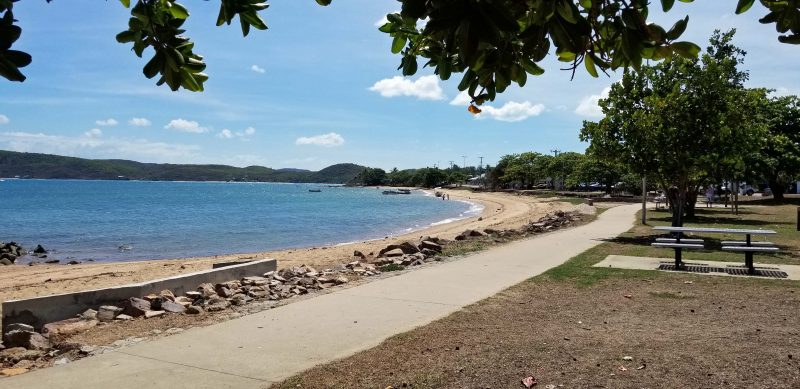Today (Wednesday), Ted and I spent the afternoon on Thursday Island at the northern tip of Queensland. It is the northernmost village in Australia and serves as the administrative and main population center of the Torres Strait Islands. The island is small–1.4 square miles in area with a population of less than 3,000 people, surrounded by beautiful turquoise water. It averages 300 days of sunshine annually. There is one hospital, one post office, one school, etc., but five churches and (naturally) six pubs.
The origin of the name “Thursday Island” is uncertain. Wednesday Island was named by William Bligh (yes, the Captain Bligh of mutiny fame), who might also have named Thursday Island. In the late 19th century, the names of Wednesday and Thursday Islands were swapped so the islands would be in weekday order. Wednesday and Tuesday islands are uninhabited; Friday Island has minor development. The whereabouts of Saturday, Sunday, and Monday islands remain unknown.
A sad fact about Thursday Island is that there’s water, water everywhere, but not a beach to swim. It’s dangerous to swim at the beach because of sharks, crocodiles, and a large, dangerous jellyfish-like creature called a marine stinger, which has tentacles that are 9 m long. Need I mention that the marine stinger (like the sharks and crocs) packs a wicked bite? On the positive side, Shoeless Jeff would fit right in here. Many current Thursday Island residents still live by a no-footwear policy out of respect for the spirits believed to live on the island.
Here’s a picture of Thursday Island. It’s in the center, with a “tail” to the right and windmills and a cell tower on high ground in the middle.



Before cultured pearls became common, Thursday Island had a thriving pearl-fishing industry. Divers came from Japan, Malaysia, and India to harvest the precious stone of the gold-lipped oyster. Pearl diving at that time was a very dangerous profession because it was done by free-diving without helmets or oxygen. As a result, many divers died. Along the beach walk, called the “Parade,” there is a sculpture honoring the pearl-diving industry on Thursday Island.

We spent some time walking around the downtown area of the island admiring the scenery, and we visited the island’s cultural museum where we learned about local culture and history. I found it interesting that, in the past, sailors on luggers (small sailing ships) would flatten the mainmast in heavy seas. This allowed the lugger to remain relatively steady in the water, gently rising and falling with the waves. It was said that a good sailor could keep the lugger steady enough to cook a pot of rice until it was finished while the ship sailed through the rough waters. On less steady ships, the rice sometimes had to be eaten before it finished cooking.
Our next destination was the Green Hill Fort. The fort was built in the 1890s because of concerns about a Russian invasion. It was shut down 30 years later and then reactivated during World War II as a wireless station. Walking to the fort took us up a very steep hill all the way–no breaks. We zigzagged our way upward for about three-quarters of a mile in the 90-degree heat, then down again (much easier) and finished two bottles of water in that mile and a half, plus two more during the rest of our time on the island. Luckily, there was a nice ocean breeze to dry our sweat as we walked. We didn’t “drip” until we stopped walking. Here’s a picture of a cannon at the fort aimed over the Torres Strait.

It was easy to find beautiful scenery on the island.



We also saw some interesting sights not included in the travel brochures. One was a discarded cigarette box. There’s nothing like putting the health risks of smoking cigarettes right in your face with straight talk and a picture of blackened lungs. The warning is more eye-catching than the brand name at the bottom of the box front.

Ted and I also named a new species of animal: the motionless flat frog. There were few sidewalks and little traffic, so we walked on the roadsides and saw a lot of those frogs in the traffic lanes. The little critters must abound on the island. (The dark edges are shadows, not indentations in the road surface. The motionless flat frog is lying on the road.)

After about an hour-and-a-half of walking in the hot sun, we took a break and sat in a shady park to cool down a little bit. A man from our ship offered to take our picture.

Because of shallow water, our ship had to anchor quite a distance from Thursday Island. In fact, it was out of sight of the island. It was about a 30-minute ride each way by tender from the ship to the island and back. The tenders hold 260+ people and also serve as lifeboats. Their downfall is that they are very hot inside. (Better hot than dead in an emergency, right?) For our shuttle ride back and forth, the crew left the two side doors open for air, but we didn’t really have any air circulation until the pilot got creative and stuck a water bottle in a top escape hatch to prop it open. Clever!


Tonight our captain will take us south through the Coral Sea along the eastern coast of Australia. Our next stop: Cairns, Australia with an excursion to the Great Barrier Reef. Meanwhile, a day at sea tomorrow and more onboard fun and relaxation.